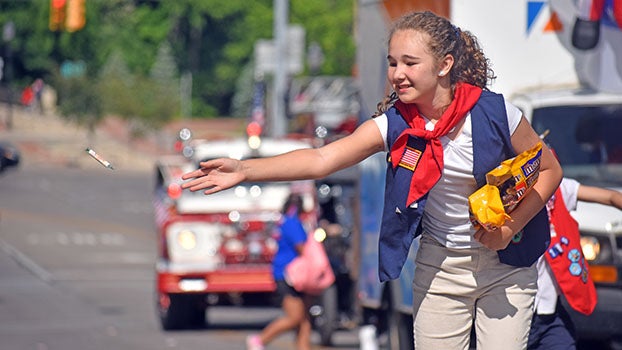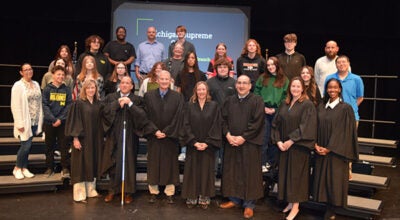Freedom seekers
Published 11:54 pm Thursday, April 21, 2011
What culminated in that August confrontation had simmered since spring.
During the Easter holiday of 1847, 12 African Americans from Kenton and Boone counties emancipated themselves from Kentucky farmers who enslaved them.
African Americans followed a plan assembled in secrecy to steal away on foot for a 12-mile walk under cover of darkness to Covington.
They picked their way to the river bank, located a boat and rowed across the Ohio River to Cincinnati.
These “freedom seekers” — a more heroic term than “runaway slaves,” decided the makers of Sanctuary and Deliverance, the outdoor mural project started in 2008 and completed in Cassopolis last summer depicting the 1847 Kentucky Raid on Cass County — did what most enslaved blacks had to do to break their bonds.
They took the first steps to freedom by themselves because no Underground Railroad existed on southern soil.
It is claimed that more than 1,500 freedom seekers passed through Cass County enroute to Canada on a route through Schoolcraft, Battle Creek, Jackson, Ann Arbor, Detroit and, finally, Windsor.
Lead artist Ruth Andrews told Dowagiac Rotary Club Thursday noon at Elks Lodge 889 that she started with the premise it would illustrate “what peace looks like in Cass County.”
The mural on S. Broadway on Stephen Woods’ law office, overlooks the Village Floral parking lot.
“At that time,” Andrews related, “Cass County had the second-biggest population of blacks in Michigan — second to Detroit.”
Andrews, who spoke as the guest of County Commissioner Robert Wagel, R-Wayne Township, a Kentucky native, staffs the county Human Services Coordinating Council, so “it’s wonderful to be introduced as an artist.”
There is now an Underground Railroad tour of Cass County with 10 points of interest, including the mural (urscc.org).
The society is restoring the Bonine House, which is another tour stop.
“Once they crossed the Ohio River, they had to get to Indiana,” she said, “and the Underground Railroad was organized very loosely, so a lot of times they didn’t have anyone to meet them on the other side. There were many unknowns.
“But if they got here and hooked up with Quakers — the Bonines, the Bogues, the Easts, the Shugarts, the Osborns — they offered land and a cabin, so they had their own homes and could grow vegetable gardens.”
Chain Lake Baptist, founded in 1838, was the second African American church in Michigan.
Kentucky slave owners, angered by the thought of Ramptown near Vandalia, formed an association and hired a “spy” named Carpenter, who came to Kalamazoo and posed as an abolitionist newspaper reporter.
“He visited the Quakers and the cabins and made a map showing where they were and who lived in them, so when he took the map back to Kentucky and gave it to the association, they knew where their runaway slaves were. They planned an expedition to recapture their ‘property.’ They first went to Battle Creek, back to Bristol, Ind., to regroup, then came up to Cass County. They made a camp near Shavehead Lake. They had two wagons.”
Lore has one of those wagons being pushed into either Shavehead or Birch lakes, “but I don’t think there’s any evidence that this happened,” Andrews said.
Split into three parties, they captured nine freedom seekers, men and women alike.
Although no one died, there was violence between the Kentuckians and some black men inside the cabins.
Several black men resisted invaders trying to shackle them.
Josiah Osborn defused the tinderbox by offering a gathering mob a compromise to settle the dispute in court at Cassopolis.
The nine captured and 34 others left Cass within a few days of the raid, meaning that at least 43 blacks lived in the county in August 1847.
In the courtroom, the confident Kentuckians were dealt a loss and sent home empty-handed, denouncing “scoundrels” thwarting their attempt to recover their “property. They didn’t have ‘certified proof.’ ”
Such complaints flowed from the pages of their local newspapers to the Kentucky legislature to the floor of Congress in Washington, adding fuel for the 1850 Fugitive Slave Act.
By the time a second trial took place in U.S. Circuit Court in Detroit, the new fugitive slave law scored Kentucky a win over Cass County abolitionists.
The unsuccessful recapture of human “property” in Cass and Calhoun counties and in other states inflamed the conflict between northern and southern states which led ultimately to the Civil War150 years ago.
“We had a year to plan it and doing the mural project taught us a lot,” Andrews said. “We had to design it together. On our planning committee we had two African American scholars (Veta Tucker and Alisea McLeod) who had done a lot of research. We talked a lot about the language we were using and made changes in my original design based on those discussions.”
The mural was funded in part by the Michigan Humanities Council, an affiliate of the National Endowment for the Humanities, with additional support from the Cass County Minority Coalition and Cass County Council on Aging.
Dowagiac artist Jerry Schlundt helped Ruth transfer her line drawings to wall-size grids.
“We started in March on the wall, power washing it, tuck pointing it, scraping it with wire brushes and putting on primer and base coat. That took until May. Just getting the scaffolding up was a big deal.
“We took cloth bags full of charcoal dust and hit them against all the lines. It goes through holes and makes lines on the wall. You take a carpenter’s crayon and draw over the lines for patterns on the wall. It’s the same process Michelangelo used. I’m good with heights and I loved doing it. The wall, one unit tall by four units long, is a really tough design format.”
Andrews and Marty Kaszar belonged to WAND, women’s activists for new directions.
“Marty wanted to do a peace garden,” with the mural as a backdrop. “I didn’t want to do that, so I asked myself what peace what would look like in Cass County. I remembered the story I’d heard (former Vandalia village president) Sondra Mose-Ursery and Tucker told (at Juneteenth),” Andrews said.






